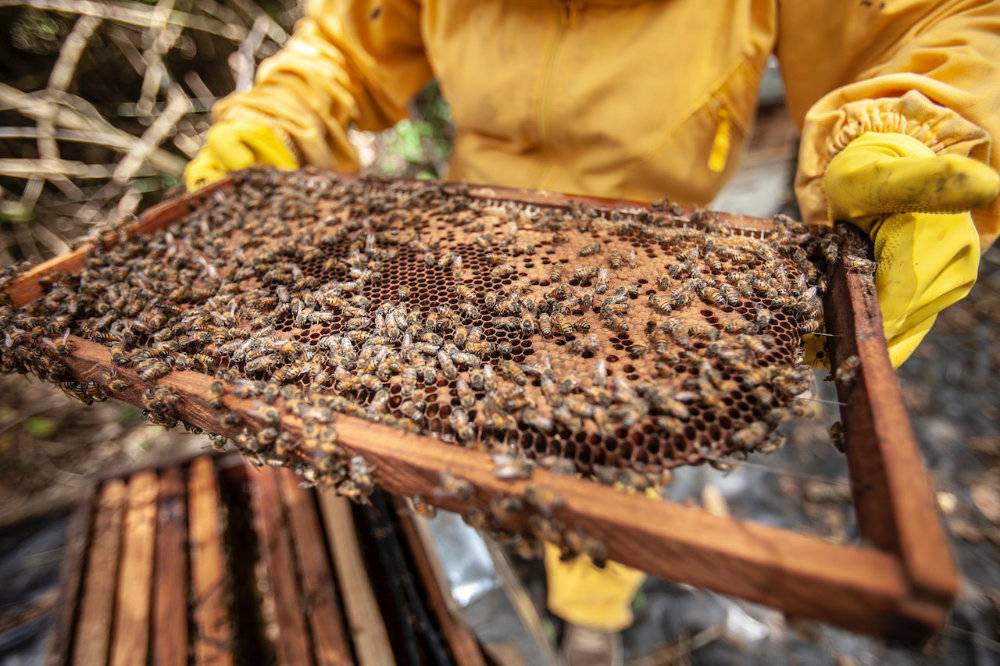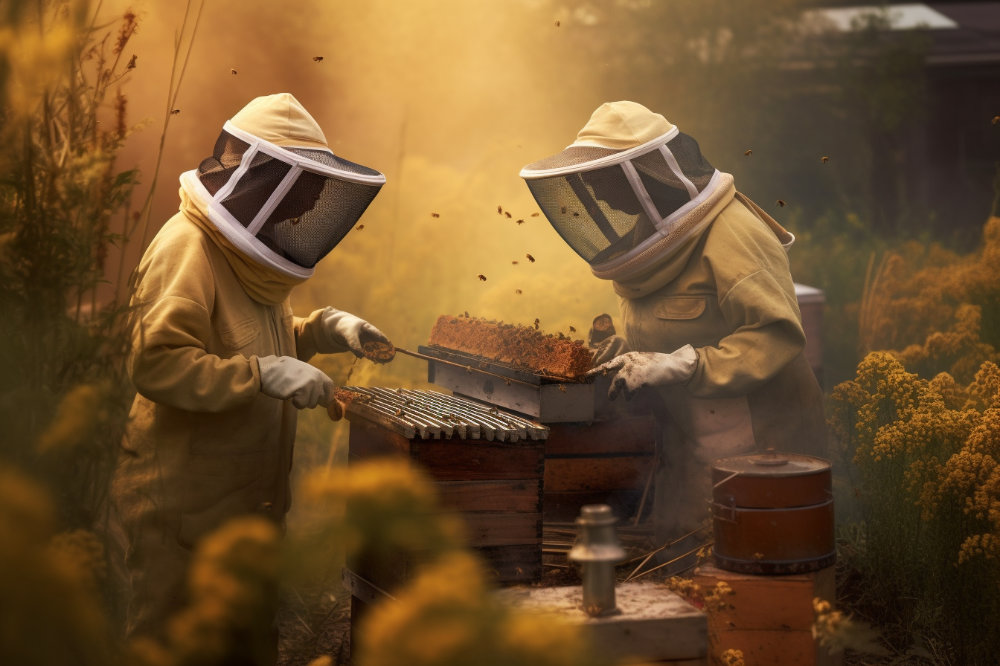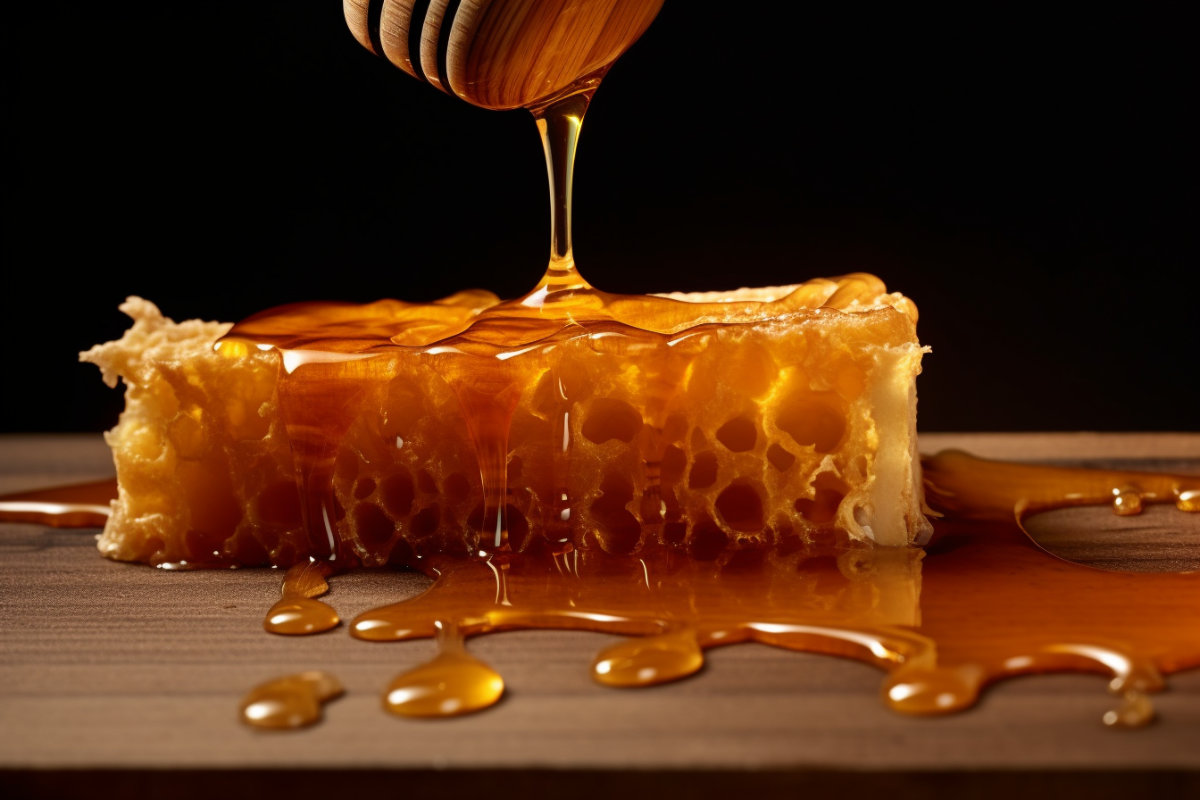A brief overview of Beekeeping
Beekeeping, also known as apiculture, is the practice of maintaining bee colonies in man-made hives. This process can be traced back to ancient civilizations such as Egypt, where illustrations of beekeeping practices were found in the Sun Temple near Cairo. In modern times, beekeeping is performed for various reasons, including honey production, pollination of crops, and the production of beeswax, propolis, and royal jelly. Beekeepers, known as apiarists, manage colonies of bees in hives and extract their honey as a primary product.
Importance of honey bees
Honeybees play an essential role in our ecosystem, primarily through their pollination activities. As they move from flower to flower collecting nectar for honey, they also transfer pollen between flowers, enabling fertilization and contributing to the growth of a diverse range of flora. This helps maintain biodiversity and is critical for food crops that rely on pollination. Additionally, honey bees produce honey, a natural sweetener, and other bee products such as beeswax and propolis, which have various applications in our daily lives.
Honey Production: A Detailed Look

How honey is made by bees
The process of honey production begins when honey bees collect nectar, a sweet liquid secreted by flowers. The bee uses its long, tube-shaped tongue to extract the nectar and store it in its extra stomach, or “crop.” Enzymes in the crop break down the complex sugars of the nectar into simpler ones. Back at the hive, the bee regurgitates the nectar to another “house” bee, who continues the process until the partially digested nectar is finally deposited into a honeycomb cell. Over time, the bees fan their wings to evaporate excess water from the nectar, turning it into thick, sweet honey. Once the process is complete, the bees seal the cell with a wax cap to preserve the honey for later consumption.
Honey extraction process
When beekeepers extract honey, they typically begin by removing the frames from the hives on which the honey is stored. They then use a special tool to remove the wax cap from each cell, a process known as uncapping. After uncapping, the frames are placed in an extractor, which uses centrifugal force to spin out the honey from the comb. The honey is collected at the bottom of the extractor and then strained to remove any remaining wax particles. After straining, the honey is ready to be jarred and consumed. Throughout this process, care must be taken to minimize disturbance to the bees and ensure their survival and well-being.
The Impact of Honey Extraction on Bees
Immediate effects of honey extraction
Honey extraction often causes some degree of disruption to the bee colony. The bees may become agitated or defensive, as their home is being intruded upon. Immediately following the removal of honey, the bees will notice a reduction in their food stores, which could increase their foraging activity. In the short term, bees may increase their nectar collection efforts to compensate for the loss, which could potentially lead to stress within the colony.
Long-term effects on bee colonies
In the long run, continuous and irresponsible honey extraction can have several negative effects on a bee colony. It may weaken the hive’s overall strength, especially if too much honey is taken without leaving enough for the bees to feed on during winter or periods of nectar scarcity. A weakened hive is less productive and more susceptible to diseases and pests. In extreme cases, this could lead to the collapse of the entire colony.
The Human Role in Bee Health Post-Harvest

Methods beekeepers use to ensure bee health
Responsible beekeepers use various methods to ensure the health of their bees post-harvest. These methods include:
- Limiting the frequency of inspections and honey harvesting to reduce stress on the bees.
- Ensuring that they leave enough honey for the bees to feed on during winter or periods when nectar is scarce.
- Regularly monitoring the bees for signs of disease or pests, and intervening as necessary.
- Providing a clean and safe environment for the bees to reduce the risk of contamination or predators.
Mitigating the negative effects of honey extraction
Several measures can be taken to mitigate the negative effects of honey extraction:
- Beekeepers can adopt sustainable harvesting practices, like only taking excess honey and leaving sufficient reserves for the bees.
- They can replace the honey taken with a suitable substitute like sugar syrup during lean periods, though this should be a last resort, not a regular practice.
- Following natural beekeeping philosophies that prioritize the health and well-being of the bees can also be beneficial.
Role of artificial feeding
Artificial feeding is a controversial topic among beekeepers. It is typically done using a syrup made from sugar and water, which is given to the bees when their honey has been taken, and natural sources of nectar are scarce. While this can be a lifesaver for bees during times of scarcity, it’s a poor substitute for the nutrients found in honey. Therefore, it should be used minimally and strategically, while the primary focus should remain on sustainable beekeeping practices that allow bees to maintain their natural behaviors and diets.
Case Studies: Effects of Honey Extraction
Effects of responsible honey extraction: A Success story
Consider the example of an apiary in the Netherlands, which employs sustainable honey harvesting practices. The beekeepers here carefully monitor the honey reserves and only harvest excess honey, ensuring that the bees have enough to sustain themselves. By prioritizing the bees’ needs, these beekeepers have observed that their colonies are healthier, more productive, and more resilient to diseases and pests. Their honey yield, while possibly lower than intensive operations in the short term, remains consistent and reliable over the years, proving the economic viability of such practices.
Effects of irresponsible honey extraction: A cautionary tale
On the other hand, an intensive honey farm in North America learned the hard way about the dangers of over-extraction. To maximize their short-term profits, they harvested nearly all the honey from their hives, replacing it with sugar water as a cheaper alternative. Over time, the bee colonies became weaker and less resilient, leading to a high colony loss rate during a harsh winter. The losses resulted in significantly reduced honey production in the subsequent years, and the added costs of replacing the lost colonies virtually erased their previous short-term gains.
Balancing Honey Harvesting with Bee Health

Sustainable beekeeping practices
Sustainable beekeeping practices prioritize the health and well-being of the bees over maximum honey production. These practices include:
- Harvesting only the excess honey and ensuring enough reserves for the bees.
- Regularly monitoring the hives for any signs of disease or distress.
- Minimizing the use of artificial feeds and letting bees forage naturally.
- Avoiding the use of harmful pesticides and chemicals in and around the hives.
- Creating a hive environment that replicates natural conditions as much as possible.
The Role of Consumers in promoting bee health
Consumers play a crucial role in promoting sustainable beekeeping practices. By choosing to buy honey and other bee products from producers who use sustainable practices, consumers can support the health and survival of bees. Additionally, they can support conservation efforts to preserve and create bee habitats. Consumers can also spread awareness about the importance of bees and the need for sustainable beekeeping practices. Through their buying choices and advocacy, consumers can play a significant role in ensuring the well-being of bees and, by extension, the health of our ecosystem.
Conclusion
The importance of understanding the impact of honey extraction
Understanding the impact of honey extraction on bees is crucial for their conservation and for the sustainability of our ecosystem. Honey bees play a vital role in pollination, which in turn supports biodiversity and food production. By recognizing the immediate and long-term effects of honey extraction, we can implement practices that ensure the well-being of bee colonies, promoting a more sustainable co-existence.
Future Directions for sustainable beekeeping
The future of beekeeping lies in balancing the need for honey production with the health and sustainability of bee colonies. This includes adopting practices such as selective and minimal honey extraction, providing natural foraging opportunities, and reducing the use of artificial feeding. Additionally, research into bee health, behavior, and honey production can provide further insights that will guide sustainable beekeeping practices. Education for both beekeepers and consumers about the importance of sustainable practices will also be a crucial component of this effort.
Frequently Asked Questions about Honey Bees and Honey Extraction
Can taking honey kill bees?
Inappropriately managed honey extraction can indeed lead to the death of bees, primarily through starvation if they are left without enough food reserves. However, if managed properly, honey extraction does not directly harm bees.
How much honey should be left for the bees?
This can vary depending on the local climate and the specific species of bee, but a common rule of thumb is to leave about 20 pounds (or 9 kilograms) of honey in the hive to help the colony survive through winter.
What time of year is best to harvest honey?
The best time to harvest honey is usually late summer or early fall after bees have had the full summer to collect nectar and produce honey. At this point, the honey is ripe and the combs are fully capped.
What are the signs of a healthy bee colony post-harvest?
Signs of a healthy colony post-harvest include active bees, the presence of a healthy queen, evidence of brood rearing (such as eggs, larvae, and capped brood), sufficient honey stores, and no signs of disease or pests.
